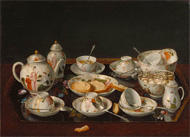1. Begin by discussing the painting Still Life: Tea Set using the following questions.
• What do you see in this painting?
• Why do you think the artist chose to present the tea set after it had been used?
• In the late 18th century, imported porcelain was still a luxury item. Liotard contrasts the fine porcelain with a painted tin tray that was made to imitate imported Asian lacquer. Why do you think he chose to show these costly items on a cheap imitation lacquer tray? (By the time this painting was made, Europeans had found the recipe for true hard-paste porcelain, but European artists never mastered the art of creating Asian lacquer, and it was cheaper to create imitation items such as this tray.)
• What other imported item do we see in this painting besides the porcelain? (Tea. In the late 18th century, tea was also a luxury item imported from the Far East.)
• What associations do we make when we think of having tea? (Students might think of teatime, and often the drinking of tea is still associated with wealth. Remember that in the 18th century, tea was still a luxury item, whereas today we all drink tea at home, or we can get it anywhere we go, such as restaurants, Starbucks, etc. Throughout the 1700s, tea was made in concentrated form and was very strong and quite bitter. It was then diluted with hot water. Because tea was so expensive and precious, people served it from small teapots and often reused the tea leaves.)
• If you were going to paint a still life of a porcelain tea set, how would you choose to present your subject?
2. Discuss with the class what a haiku poem is. A haiku is a Japanese verse form that when rendered in English becomes three unrhymed lines of 5, 7, and 5 syllables, often on a subject of nature. Do an Internet search on haiku and review haiku poetry with the class.
3. Simplicity of design is an important aspect of artwork made by the Japanese and Chinese.
• How does simplicity apply to the haiku poems that you have looked at?
• In addition to using nature as a subject, what do you find that most haiku poems have in common?
4. Examine the painting Still Life: Tea Set and have students write a haiku poem based on what they see in the painting. Once students are finished have them read aloud their poems to the class. If you need to, use the following as an example haiku:
Chinese porcelain
Scattered and in disarray
Tea time is over
How does the simplicity of the student's poems convey the meaning of the painting?
5. As a class, examine other works from the Getty collection. Examine the two portraits: Portrait of John, Lord Mountstuart, Later 4th Earl and 1st Marquess of Bute, also by Jean-Etienne Liotard, and Gabriel Bernard de Rieux by Maurice-Quentin de La Tour.
• How do these two works relate to the theme of chinoiserie? What elements can you find that are from China or the Far East?
• What do these other works from the Getty Museum's collection tell us about the ownership of imported objects from China and other parts of Asia?
6. After looking at these works of art, have students create another haiku based on what they see. Once they are finished, have them share their poems with the class and discuss.
If a haiku is supposed to represent its subject with simplicity, how would you compare the simple poem to the opulent objects and decorative interiors you see in these works of art? |
 |
 |
 |
| Still Life: Tea Set, Jean-Étienne Liotard, 1781–1783 |
 |
|
 |
Common Core Standards for English Language Arts
Grades 6–8
WRITING
Production and Distribution of Writing
4. Produce clear and coherent writing in which the development, organization, and style are appropriate to task, purpose, and audience.
SPEAKING AND LISTENING
Comprehension and Collaboration
1. Prepare for and participate effectively in a range of conversations and collaborations with diverse partners, building on others' ideas and expressing their own clearly and persuasively.
2. Integrate and evaluate information presented in diverse media and formats, including visually, quantitatively, and orally.
History—Social Science Content Standards for California Public Schools
Grade 7
5.6 Students analyze the geographic, political, economic, religious, and social
structures of the early civilizations of China.
6. Cite the significance of the trans-Eurasian "silk roads" in the period of the Han
dynasty and Roman Empire and their locations.
7. Understand the importance of both overland trade and maritime expeditions
between China and other civilizations in the Mongol Ascendancy and Ming Dynasty.
8. Trace the historic influence of such discoveries as tea, the manufacture of paper,
wood-block printing, the compass, and gunpowder.
Visual Arts Advanced Content Standards for California Public Schools
Grade 9—12
3.0 Historical and Cultural Context
Understanding the Historical Contributions and Cultural Dimensions of the Visual Arts
Students analyze the role and development of the visual arts in past and present cultures throughout the world, noting human diversity as it relates to the visual arts and artists.
Diversity of the Visual Arts
3.3 Investigate and discuss universal concepts expressed in works of art from diverse cultures.
5.0 Connections, Relationships, Applications
Connecting and Applying What Is Learned in the Visual Arts to Other Art Forms and Subject Areas and to Careers
Visual Literacy
5.2 Compare and contrast works of art, probing beyond the obvious and identifying psychological content found in the symbols and images. |
 |

|
 |





